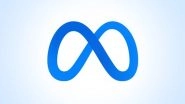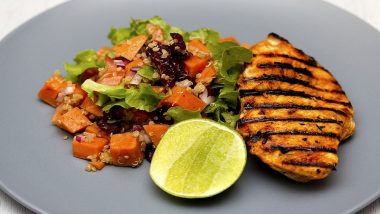Whenever we think of weight loss, the first thing that comes to our mind is diet. Diet should be appropriately planned and taken by a duly certified dietitian. If we prepare our diet plan without any guidance or consultation, then it is as dangerous as self-medication. Now there is one diet which is very popular these days, it's known as the Keto Diet. Keto diet is the trending topic in the world of nutrition these days. Let us have an overview of this low carb high fat ketogenic food along with its pros and cons. Keto Breakfast Recipes: Ditch Expensive Restaurants! Quick and Easy Meals You Can DIY at Home If You Are on a Ketogenic Diet.
What is Ketogenic Diet?
This diet is high in fat and low in carb, in which one has to reduce the carbohydrates intake drastically and increase the consumption of fat. By doing this, the body will enter into a metabolic state called ketosis. This enables in burning of fat, which is used as fuel to generate energy. In this diet, fat turns into ketones in the liver, which supplies energy to our brain. Reduction in blood sugar and insulin level are also observed while practising this diet.
Different types of Ketogenic diets
Before opting for the proper keto diet from below, you should know a few important stats to calculate the intake of each macronutrient-carb, protein and fat.
We will consider the daily calorie intake of 2000 calories in our calculation.
One gram of fat contains 9 calories.
One gram of protein contains 4 calories.
One gram of carbohydrate contains 4 calories.
Below are some types of Keto diets
1. Standard Ketogenic Diet(SKD): This is a very low carb, moderate protein and high-fat diet. Here you will have to achieve a macro breakdown of 75% fat, 20% protein and 5% carbs. Here is how you will have to calculate the intake of each macronutrient.
Fat- 2000 calories x 75% fat = 1500 calories,1500 calories/9 calories per gram= 167 gm of fat.
Protein- 2000 calories x 20% protein = 400 calories, 400 calories/4 calories per gram= 100 gm of protein.
Carbohydrate- 2000 calories x 5% protein = 100 calories, 100 calories/4 calories per gram = 25 gm of carbohydrates.
Now if you are opting for SKD and choosing to eat 2000 calories a day, then you will have to eat 167 gm of fat, 100 gm of protein and 25 gm of carbohydrates.
2. High Protein Ketogenic Diet(HKD): Here the only difference is that it includes a bit high percentage of protein as compared to SKD, here the macro breakdown is 60% fat, 35% protein and 5 % carbs. You will have to apply the same calculation as above to calculate the consumption of each macronutrient. After calculation, you will find that intake of 133 gm of fat, 175 gm of protein and 25 gm of carb is necessary for this diet.
3. Cyclical Ketogenic Diet(CKD): In this diet, five days of a keto diet is followed by two days of high carb diet, bodybuilders or athletes usually choose this diet.
Pros
1. Helps in reducing body fat: Keto diet includes low carb and high fat, which creates a situation in which the body uses the fat as fuel to release energy, which boosts burning and also increases the metabolism. Also, a high intake of fat, keeps one full and enable less craving.
2. Perfectly suits a sedentary lifestyle: Most people in metropolitan cities have a busy work schedule which involves sitting on the desk for hours. It is difficult for these people to manage even 30 mins for a workout from their daily timetable. These people mostly don't require much protein as they hardly do weight lifting exercise and their primary goal is to attain just basic fitness.
3. Reset Insulin Sensitivity: Ketogenic diet may help boost your sensitivity to insulin, as a period of low carb intake will ensure that you can safely reintroduce carbohydrates at a later stage, without making an impact to physique or performance.
Cons
1. Our brain stops getting the sugar: Focus is not only required while exercising in the gym, but it is also necessary for work. Our mind functions accurately when it gets proper glucose; now keto diet involves very less intake of carbs which in turn leads to minimum development of blood glucose. The carbs which we eat are needed for glucose to enter the bloodstream, less consumption of carb might take a hit on cognitive function.
2. Carbs fuel performance: Carbs are required to generate massive energy. It enhances our athletic performance. If you are an athlete doing weight training or other physical exercises lasting more than 90 mins, then carbs is a must. The consumption of complex and starchy carbs aids intense workout and also leads to less muscle loss. Ketogenic diet highly involves the risk of muscle loss as fat does not work as effectively as the carb for generating energy in our body. Carb Loading: What are The Benefits of Increasing Carbohydrate Intake and How to Do It.
3. Calories intake plays a significant role: Losing weight means cutting down on your total calories consumed. Basic dieting guidelines say to keep a ratio of carb, protein and fat as 2:1:1. Therefore one has to manage their macronutrients intake accordingly and balance it by burning those calories through exercising. Ketogenic diet mostly focuses on high intake of fat and not on the overall calorie count.
Now whether, the ketogenic diet is good or not, the debate for this topic can go on and on. However, one thing is clear that if you are on a weight loss, your dedication, discipline towards fitness and will power matter the most. No diet can be termed as bad for your body, provided you keep changing your diet plan as per the guidance from your dietitian. One same food for your body over a while eventually becomes futile, as our body gets used to it and stop giving the result.
(This article is written for an informative purpose and should not be substituted for medical advice. Kindly consult your doctor before trying any tips.)
(The above story first appeared on LatestLY on Feb 21, 2019 01:28 PM IST. For more news and updates on politics, world, sports, entertainment and lifestyle, log on to our website latestly.com).













 Quickly
Quickly


